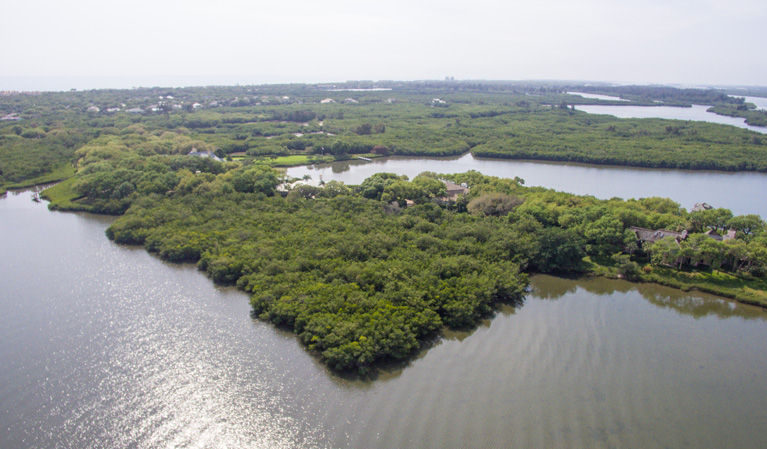
If the U.S. government gets its way, a long-simmering 32963 land-use dispute will be decided by the United States Supreme Court later this year.
Solicitor General Donald B. Verrilli, Jr. filed a 265-page “brief” on March 17 asking the Supreme Court to hear the government’s appeal of a lower court decision awarding $4.2 million to Lost Tree Village Corporation, developer of John’s Island.
The money would represent the fair market value of a 4.99-acre parcel on Stingray Point in the club community that the U.S. Army Corps of Engineers prevented Lost Tree from developing in 2004, citing the Clean Water Act.
If the court declines to hear the case, or hears it and upholds the lower court’s ruling, the government will be liable for Lost Tree’s legal fees and 12 years’ worth of interest on the $4.2 million, which together could double the size of the award.
“The interest will be a hefty number – several million,” says Jerry Stouck of Greenberg Traurig LLP, who has represented Lost Tree throughout its protracted legal battle with the government. “There was a seven-day trial and the government has appealed the case twice (already), and is now trying to appeal to the Supreme Court, (so) legal fees will be substantial, running into seven figures.”
Stouck has until April 22 to file his response to the government’s last-ditch appeal, arguing that the lower court was correct and the Supreme Court should not hear arguments in the case.
The justices will consider the government’s petition at an end-of-the-week case conference sometime in May or the first week in June. Three justices have to agree the case is worthy of the court’s time and attention for it to get on the docket.
“If they take it, there is not enough time to brief it for the current term, so it will be held over until the fall,” Stouck says. “It will be briefed over the summer, heard in the fall and decided by the end of the year.”
If the court declines to hear the case, it will be sent back to United States Court of Federal Claims where it started. There, a judge will hear arguments and rule on the exact amount of interest and legal fees the government must pay, and the long-running legal battle will finally reach its conclusion in late summer or early fall.
“If they don’t hear the case, It will certainly be wrapped up by September,” Stouck says.
The history of the case occupies many pages in the Solicitor General’s March 17 Petition for a Writ of Certiorari, the technical name of the government’s request for a hearing before the Supreme Court, but it can be told more briefly.
In 2002, Lost Tree applied to the Army Corps of Engineers for a permit to fill wetlands on the 4.99-acre tract, known as Plat 57, in order to develop it for homebuilding. In 2004, the Corps replied in a letter to Lost Tree president Charles Bayer, informing him the project was “contrary to the overall public interest. Therefore, your . . . permit is hereby denied.”
Wetlands are crucial to the ecological health of the Indian River Lagoon, filtering water and serving as fish nurseries, and the Corps decided it would damage the ecosystem to drain the wetlands on Lost Tree’s property.
Four years later, in 2008, Lost Tree challenged the denial in the Court of Federal Claims, arguing that the government had violated its fifth amendment rights by taking the value of the property without paying due compensation. (With a fill permit the property was worth millions. Without the permit it was worth only $27,500, according to court calculations.)
The Court of Federal Claims found for the government, agreeing with the argument that Plat 57 was part of a larger “parcel” of John’s Island property, from which Lost Tree had already profited handsomely.
Lost Tree challenged that decision in the United States Court of Appeals, which reversed the lower court, agreeing with Stouck’s argument that Plat 57 was a discrete property that had never been part of any larger master plan. That being the case, the Corps’ refusal to issue a permit wiped out more than 99 percent of the land’s value and made the government liable, under the Fifth Amendment and legal precedent, to compensate Lost Tree.
The case bounced back and forth between the Court of Federal Claims and the Court of Appeals several more times, as the value of the property was adjudicated and the ruling in Lost Tree’s favor was upheld against the government’s appeals.
On June 1, 2015, the Court of Appeals definitively affirmed the judgment, leaving the government one final recourse. After getting the deadline to respond extended twice, the government filed its petition to the Supreme Court on March 17, all 265 pages of it, arguing that the lower court erred in viewing Plat 57 as a separate, self-contained economic opportunity.
“It is tough to fight city hall,” Stouck says. “The Justice Department fights like hell. They don’t like to lose, and they see these as important legal issues.”
Lost Tree does not deny the Corps’ right to protect wetlands under the authority of the Clean Water Act. It merely says that if the government is going to protect the wetlands at its expense, it should be compensated. So far the federal courts have agreed with the company.
If the Supreme Court refuses to hear an appeal from the government, or hears the case and affirms the lower court’s ruling, Lost Tree will still be prohibited from developing the property it owns on Stingray point but it will be $7 million or $8 million richer and have the satisfaction of prevailing against city hall.



